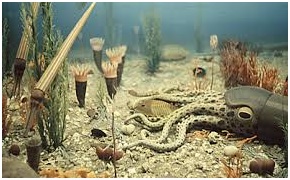Name: Ordovician
Period: 485.4-443.8 m.y.a
Average Temperature: 16 Celsius
Atmospheric oxygen: 13.5%

After the explosion of life in the Cambrian, things remained rather unchanged in the Ordovician. The continent of Gondwana started to rise a bit toward the Equator, and the end of this period was extremely cold. You want to know why it was extremely cold? Because of ANOTHER GLACIATION. Yup, two times wasn’t enough. There had to be another. This (unsurprisingly) lowered the amount of oxygen available and murdered about 85% of ALL LIFE. Luckily, some life survived, and the life that did survive went on to become the template for the life of the rest of the Paleozoic era (not eon, eon is what I cover in these posts. Era is a collective for several eons.).
How did this template come to be? Simple. One word (Or rather, four): GOBE (Don’t laugh; it’s not as stupid as it sounds). GOBE stands for the Great Ordovician Biodiversification Event (Rolls RIGHT off the tongue, doesn’t it?) which was the event which killed off basically EVERYTHING and replaced it. This ‘everything’ was mainly animals of the open sea, and animals which were filter feeders, which basically means that they just sucked in a LOT of water, took out all the useful stuff, like, FOOD, and discarded the rest.
Orthoceras was an ancient ancestor of cephalopods, or squids and octopi. It resembled a squid and was most probably a predator and hunted trilobites (I think). A giant arthropod and close relative of the horseshoe crab was the Pentecopterus decorahensis, which was one of the largest seas scorpions ever known. Sacabambaspis was a jawless fish with protective bony plates on its head and skeletal tissue, and also primitive sensory structures. Lastly, Astrapis was an extremely small jawless fish. It was literally just a head and a tail. That’s it!
Sorry for the short post. I’m having a hard time trying to make this not sound like a documentary. Fingers crossed.
Shaurya Prasad Grade 7A